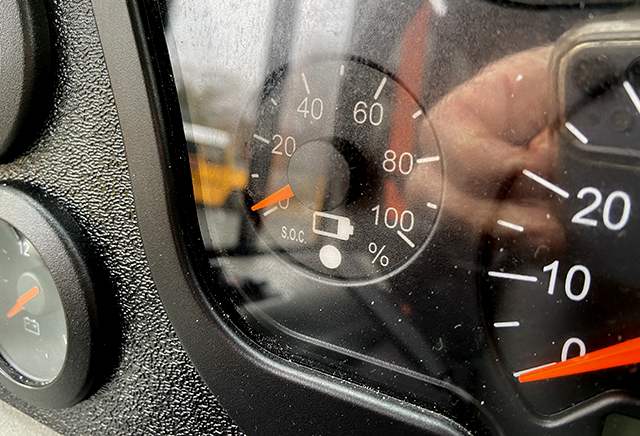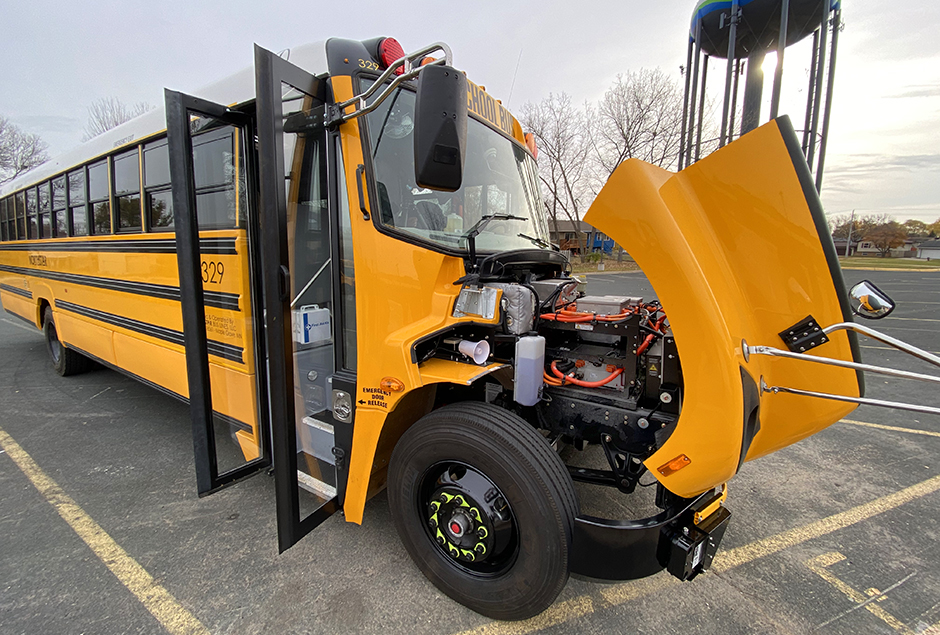For many children, part of the daily commute to school includes standing along the curb of a bus stop, inhaling exhaust emitting from an idle bus. This diesel exhaust is not only designated as a carcinogen to humans, with children being especially susceptible with their respiratory systems still developing, but along with other vehicles in the transportation industry is a leading cause of greenhouse gas emissions in Minnesota.
But now the Minnesota Pollution Control Agency hopes to reduce the number of diesel buses servicing schools with a pilot project that has awarded five bus vendors and school districts $2.1 million in grants to buy eight electric buses.
The districts getting electric buses subsidized by the pilot program are Faribault Public Schools, St. Paul Public Schools, Columbia Heights Public Schools, Morris Area School District, Fergus Falls Public Schools and Osseo Area Schools. The pilot funds up to $275,000 or 75 percent of each electric bus, with districts and/or vendors responsible for the remaining cost. (Most school districts outsource transportation to outside bus companies.)
The subsidy is significant with the high prices of electric buses. One electric bus can cost in the upper $300,000 range in comparison to diesel busses, which are usually priced around $80,000. Prior to MPCA’s pilot project, only one school district in the state — Lakeville area schools — had an electric bus.
The pilot is being funded as a part of the 10-year Volkswagen emissions settlement, from which Minnesota received $47 million.
Addressing districts’ concerns
MPCA had previously attempted a similar pilot project in 2018 but received very few applicants.
To garner more interest from the districts, MPCA invited five electric bus manufacturers together to meetings where the manufacturers talked to school districts and bus management companies about their vehicles.
“We really had to craft a pilot that would get people to apply for these grants, and we didn’t know what it was that was keeping them from applying,” said Rebecca Place, the electric vehicle program administrator at MPCA. “Are they scared of Minnesota winters? Are they intimidated by the cost of the electric bus?”
Districts were given the freedom to select their own manufacturer, with Osseo deciding on a Canadian company for a tried and true winter-friendly electric bus.
“Because they’re tested in Canada, we knew that they would be a good match for our winter driving conditions,” said Nick Martini, the transportation coordinator for Osseo Area Schools. “They have all fiberglass composite body panels and so with the salt in the roadways, these vehicles aren’t going to rust and same with the step wells where the kids walk up into the bus.”
Electric buses have an approximate 100 mile range when fully charged and the lag between morning and afternoon bus routes gives vendors the time needed to fully recharge. North Star, Osseo’s bus provider, installed five bus charging stations in anticipation of growing their electric fleet. In Osseo, two buses are currently running routes, with a third expected to join soon.
Health and climate impacts
The MPCA’s Place said one goal of the project is to demonstrate how the electric buses work in all corners of the state, with applicants broken into four geographic zones.
But that’s not the only consideration: applicants are also ranked according to each district’s air pollution levels, the number of emergency room visits in the area for asthma-related or cardiovascular-related issues and assessing the diesel bus which will be replaced — a requirement of the project is that the electric bus replace a diesel bus built before 2009.
Martini said the demographics of the east side of his district was one of the primary reasons Osseo was chosen out of 47 applicants.
“We know historically that areas of lower income and areas of higher population density are more subject to vehicle emissions because they have more city busses running in their area, they have more personal vehicles because of the population density,” Martini said. “Our demographic makeup is about 50 to 54 percent students of color, and we have a higher concentration of students of color on the east side of our district.”
Place said the project is designed to help protect vulnerable populations from fine particles from buses, such as nitrous oxide.
“The electric buses are going to reduce pollution in the air in those areas,” Place said. “So we’re hitting right at the point where we should buy by replacing these school busses so the children aren’t impacted by the diesel emissions.”

[image_credit]Minnesota Pollution Control Agency[/image_credit][image_caption]Electric buses have an approximate 100 mile range when fully charged and the lag between morning and afternoon bus routes gives vendors the time needed to fully recharge.[/image_caption]
For now, Place said MPCA will continue to collect data from the districts on factors such cost effectiveness, amount of energy consumed and regenerated, before starting another round of grants for electric school buses.
“There’s just enormous potential with electric school busses,” Place said. “If we find out that they’re a great fit and they work, I would hope to see a lot of investment in electric school busses in Minnesota in the future.”






How ia the heat on these if a bus would get stranded? More applicable to rural routes
Electric vehicles have fewer moving parts and require less maintenance. There are numerous examples of why electric vehicles are far superior to diesel. Someone should measure the level of pollution on Marquet Ave in Minneapolis during rush hour, it is amazing so many people stand in that cesspool. Big Transit buses, especially the coach type have plenty of room underneath for batteries. Five miles to the gallon of bio-diesel is no bargain. Most local transit buses don’t go over 30 miles in a route (60 a day).
Even the ones that do, can exchange a bus, for a fully charged one to finish the routes. IMO
Another example of government run amuck. I’m not opposed to EVs when they make economic sense. But these electric buses cost almost 4x as much as regular buses. That’s crazy.
You need to factor in much lower costs for energy and far lower maintenance costs. Don’t know if that will fully balance the upfront costs, but the lower operational costs needs to be acknowledged. This isn’t just about direct costs. There are hidden costs to diesel vehicles, that are borne by the society as a whole but not by vehicle operator. Things like greenhouse gas emissions, health effects from diesel particulate, and the costs associated with future consumption of a dwindling and dirty resource.
No, it’s a perfect example of government doing exactly what it should be doing. It’s a pilot program. They’re collecting data. A modest investment, to see how these experimental buses compare to their diesel counterparts.
If it proves the concept, then we’ll buy more, and as electric buses scale up, the price will come down. If it doesn’t work well, then not much ventured, not much lost.
Government at its best, something we should be proud of. The upsides are manifest…healthier rides to school, potential for lower operating costs forever, and reduced greenhouse gas emissions. We all stand to profit it if goes well. It’ll be interesting to read the report when the pilot project ends.
The design of the school buses being used today dates from the 30’s.
The VW money could have been used to reimagine the whole concept.
Sadly the democrats spend according to budget and the republicans earn off the fool.
That’s just the way it is.
But not to worry, children find asthma to be a challenge, and United Health has a bicycle racing team.
As a St. Paul resident I am pleased to see our district included in this. It is absurd that we subject our students (and others) to the diesel fumes from idling buses.
That said, I do wonder if wouldn’t be better to invest in expanded MTC bus service to have SPPS students use. Perhaps later school start times would help with this as well.
Thanks to author Yasmine Askari for writing about this. Glad to see experimentation taking place on this critical issue. Hope results are positive and can be used widely to make more efficient use of resources.